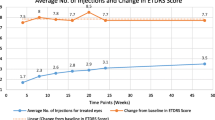Abstract
Purpose: To evaluate the short-term efficacy of intravitreal bevacizumab injection for the management of macular edema due to diabetic retinopathy and retinal vein occlusion. Methods: Patients with macular edema due to diabetic retinopathy, and retinal vein occlusion were treated with intravitreal bevacizumab and evaluated retrospectively. Standardized ophthalmic evaluation, ETDRS visual acuity measurement, and central macular thickness were performed at baseline and 1 month intervals after injection. Results: There were 23 eyes of 21 patients with macular edema due to diabetic retinopathy (14 eyes of 12 patients), and retinal vein occlusion (9 eyes of 9 patients). The mean baseline logMAR visual acuity and central macular thickness were 0.82 ± 0.27 and 604.71 ± 123.62 μm, respectively, in patients with diabetic retinopathy. There was no statistically significant difference between the mean logMAR visual acuity (P = 0.22) and central retinal thickness (P = 0.16) measurements at baseline and 3 months follow-up. The mean baseline logMAR visual acuity and central macular thickness were 0.94 ± 0.48 and 557 ± 113.9 μm, respectively, in patients with retinal vein occlusion. There was a statistically significant difference between the mean logMAR visual acuity and central retinal thickness measurements at baseline and 3 months follow-up (P < 0.01). Almost all of the eyes (88.8%) regained normal foveal configuration. Conclusions: Although our follow-up period was short and the number of patients were limited to provide specific treatment recommendations, intravitreal bevacizumab seems to be more effective for macular edema due to retinal vein occlusion than diabetic macular edema. The favorable short-term results suggest further study is needed.


Similar content being viewed by others
References
Tranos PG, Pavesio CE (2004) Macular edema. Surv Ophthalmol 49(5):470–490
Adamis AP, Miller JW, Bernal MT et al (1994) Increased vascular endothelial growth factor levels in the vitreous of eyes with proliferative diabetic retinopathy. Am J Ophthalmol 118:445–450
Gragoudas ES, Adamis AP et al (2004) VEGF inhibition study in ocular neovascularization clinical trial group. Pegaptanib for neovascular AMD. N Engl J Med 351:2805–2816
Avery RL, Pieramici DJ, Rabena MD et al (2006) Intravitreal bevacizumab (Avastin) for neovascular age-related macular degeneration. Ophthalmology 113:363–372
Rosenfeld PJ, Fung AE, Puliafito CA (2005) OCT finding after intravitreal injection of bevacizumab for macular edema for central retinal vein occlusion. Ophthalmic Surg Lasers Imaging 36:336–339
Rosenfeld PJ, Moshfeghi AA, Puliafito CA (2005) OCT findings after intravitreal injection of bevacizumab (Avastin) for neovascular age—related macular degeneration. Ophthalmic Surg Laser Imaging 36:270–271
Harıtoglou C, Kook D, Neubauer A et al (2006) Intravitreal bevacizumab (avastin) therapy for persistent diffuse diabetic macular edema. Retina 26:999–1005
Iturralde D, Spaide R, Meyele C et al (2006) Intravitreal bevacizumab (Avastin) treatment of macular edema in CRVO. A short-term study. Retina 26:279–284
Shahar JS, Aury RL, Heilweil G et al (2006) Electrophysiologic and retinal penetration studies following intravitreal injection of bevacizumab. Retina 26:262–269
Macugen Diabetic Retinopathy Study Group (2005) A phase II randomized double-masked study of pegaptanib, an anti-vascular endothelial growth factor aptamer, for diabetic macular edema. Ophthalmology 112:1747–1757
Nguyen QD, Tatlipinar S, Mahmood S et al (2006) VEGF is a critical stimulus for diabetic macular edema. Am J Ophthalmol 142(6):961–969
Tolentino MJ, Miller JW, Gragoudas ES et al (1996) Intravitreous injections of VEGF produce retinal ischemia and microangiopathy in adult primate. Ophthalmology 103:1820–1828
Costa RA, Jorge R, Calucci D et al (2007) Intravitreal bevacizumab (Avastin) for central and hemicentral retinal vein occlusions. IbeVO study. Retina 27:141–148
Pai SA, Shetty R, Vijayan PB et al (2007) Clinical, anatomic and electrophysiologic eveluation following intravitreal bevacizumab for macular edema in retinal vein occlusion. Am J Ophthalmol 143:601–606
Author information
Authors and Affiliations
Corresponding author
Rights and permissions
About this article
Cite this article
Astam, N., Batıoğlu, F. & Özmert, E. Short-term efficacy of intravitreal bevacizumab for the treatment of macular edema due to diabetic retinopathy and retinal vein occlusion. Int Ophthalmol 29, 343–348 (2009). https://doi.org/10.1007/s10792-008-9242-2
Received:
Accepted:
Published:
Issue Date:
DOI: https://doi.org/10.1007/s10792-008-9242-2




